#bogertophis
Text
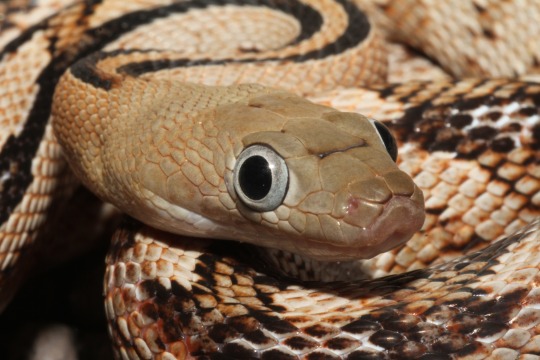
Trans-Pecos Rat Snake (Bogertophis subocularis), family Colubridae, from West Texas and northern Mexico
photograph by Dick Bartlett
547 notes
·
View notes
Text

Trans-Pecos rat snake (Bogertophis subocularis)
By: Chris Mattison
From: A Practical Guide to Exotic Pets
1994
179 notes
·
View notes
Note
So I may or may not have just gone on a research binge about ratsnakes because I was thinking about potential snakes I would want to own and the Japanese rat snake came up... they're too pretty, I want one.
While researching, I came across the discovery that not all New World ratsnakes are Pantherophis species! Particularly interesting was that the Trans-Pecos rat snake, like your Stede, is actually in the Bogertophis genus.
Anyway, my question is: what are the main differences between Old World and New World ratsnakes and between the different genera of New World ratsnakes? Is there anything we should know about them before getting a rat snake?
Ratsnakes are so cool, and their taxonomy can get really convoluted really fast. But here's what you need to know! I'm using the most commonly agreed-upon genus names for the sake of simplicity.
Old World ratsnakes fall into a few main genera. Elaphe is the big one, with ten members. Then there's Coelognathus, Ptyas, and Zamenis, Orthriophis, and a handful of other genera that have just a couple species. The general rule of thumb is that Old World ratsnakes tend to be a bit trickier than New World ratsnakes; they're often bigger and a bit more finicky. They tend not to tame down well...with a few exceptions. Snakes in Elaphe tend to make the best pets - Japanese, Russian, and Dione's ratsnakes in particular are absolute sweethearts and make awesome pets.
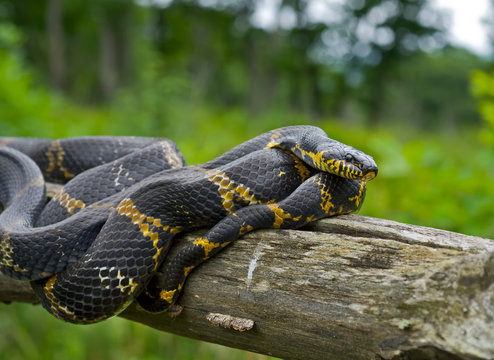
New World ratsnakes are a smaller group. The main genus, as you mention, is Pantherophis, and you've also got Bogertophis, Pseudelaphe, Senticolis, and Spilotes. Pantherophis and Bogertophis snakes make good pets as a rule; the others are generally harder to get right in captivity. As a rule, New World ratsnakes tend to be a lot easier to work with than Old World rats.
Bogertophis is just the Baja California ratsnake and the Trans Pecos ratsnake; they're both really great snakes that tend to be very docile and easy to work with. You can recognize them by their eyes - they're visual snakes who have really big eyes!
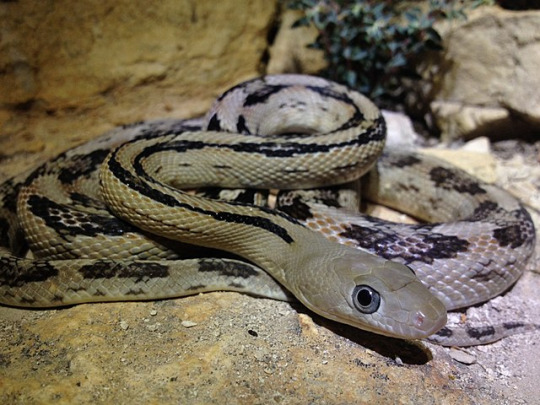
Which ratsnakes in Pantherophis make great pets depends a bit on your experience level. Cornsnakes, obviously, are great for everyone, as are Baird's ratsnakes. Most of them, like easterns, are good pets but can be a little defensive as babies. Snakes in this genus generally tame down super well with time and gentle handling.
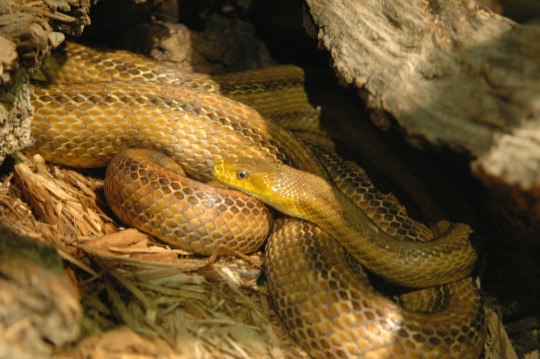
Ratsnakes are awesome pets, generally speaking. The biggest note across the board is that they're not little snakes and they really need to be able to climb - you really need a tall enclosure with lots of climbing space for these guys.
90 notes
·
View notes
Text


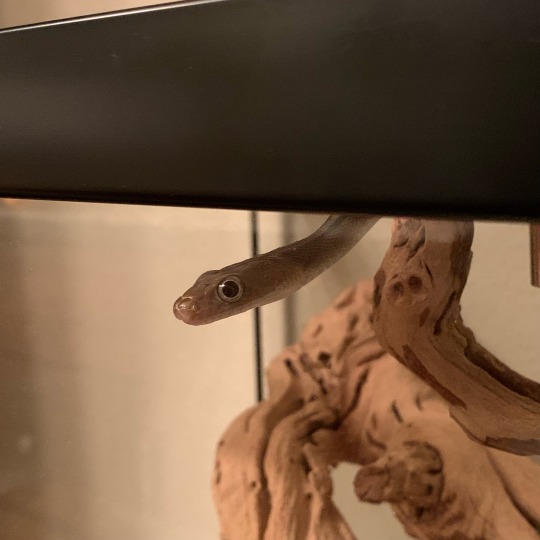


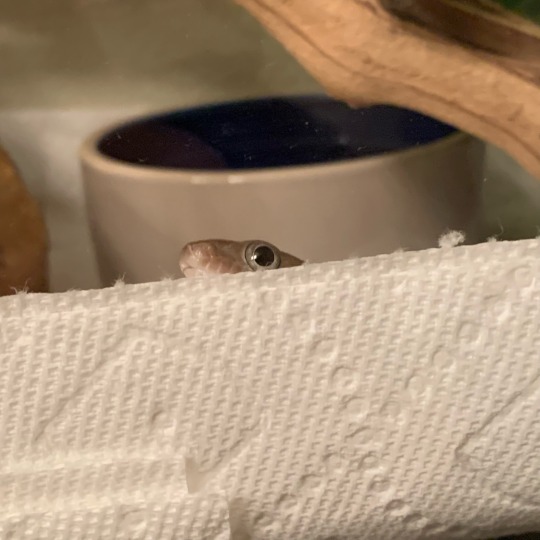

This is Echo. He is a cartoon.
12 notes
·
View notes
Photo
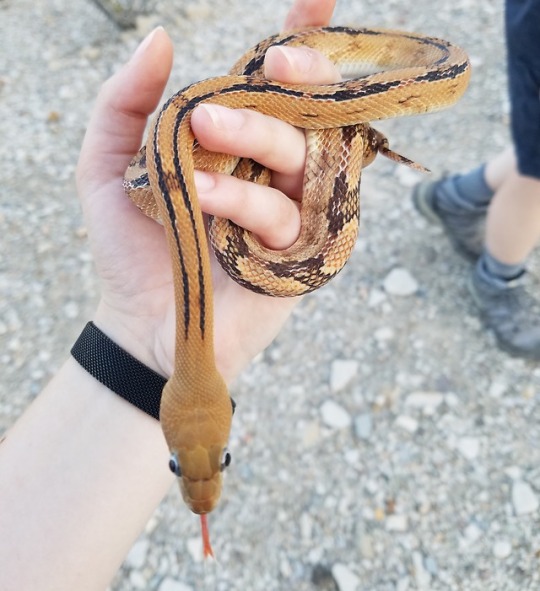
I spent the previous week in Big Bend National Park helping my professor study bat colonies and distribution within the park. While we were netting over by Mariscal Mine, I found this cute little Trans Pecos Ratsnake! (Bogertophis subocularis)
1 note
·
View note
Photo

8x10 Trans-Pecos Ratsnake Unframed, $35 shipped. #ratsnake #bogertophis #subocularis
0 notes
Text
Herp Taxa
CNAH: North American Herpetofauna: Reptilia: Squamata (part)
Names that differ in any way from those published in the most most recent joint Society names list (see introduction)
About CNAH have their Standard English name shown in green.
Statement
of Purpose Reptilia Laurenti, 1768 - Reptiles
Squamata (part) Oppel, 1811 - Snakes
CNAH Board
Boidae Gray, 1842 - Boas
CNAH Officers Charina Gray, 1849 - Rubber Boas
C. bottae (Blainville, 1835) - Northern Rubber Boa
CNAH Awards
C. umbratica Klauber, 1943 - Southern Rubber Boa
CNAH Donors Lichanura Cope, 1861 - Rosy Boas
L. orcutti (Stejneger 1889) - Northern Three-lined Boa
JNAH
L. trivirgata (Cope, 1861) - Rosy Boa
Contemporary
Herpetology
Colubridae Oppel, 1811 - Harmless Egg-Laying Snakes
Contact Us
Arizona Kennicott, 1859 - Glossy Snakes
A. elegans Kennicott, in Baird, 1859 - Glossy Snake
A. e. arenicola Dixon, 1960 - Texas Glossy Snake
A. e. candida Klauber, 1946 - Mohave Glossy Snake
A. e. eburnata Klauber, 1946 - Desert Glossy Snake
A. e. elegans Kennicott, in Baird, 1859 - Kansas Glossy Snake
A. e. noctivaga Klauber, 1946 - Arizona Glossy Snake
A. e. occidentalis Blanchard, 1924 - California Glossy Snake
A. e. philipi Klauber, 1946 - Painted Desert Glossy Snake
Bogertophis Dowling & Price, 1988 - Desert Ratsnakes
B. rosaliae (Mocquard, 1899) - Baja California Ratsnake
B. subocularis (Brown, 1901) - Trans-Pecos Ratsnake
B. s. subocularis (Brown, 1901) - Northern Trans-Pecos Ratsnake
Cemophora Cope, 1860 - Scarletsnakes
C. coccinea (Blumenbach, 1788) - Scarletsnake
C. lineri Williams, Brown & Wilson, 1966 - Texas Scarletsnake
Coluber Linnaeus, 1758 - North American Racers, Coachwhips, and Whipsnakes
C. constrictor Linnaeus, 1758 - North American Racer
C. c. anthicus (Cope, 1862) - Buttermilk Racer
C. c. constrictor Linnaeus, 1758 - Northern Black Racer
C. c. etheridgei Wilson, 1970 - Tan Racer
C. c. flaviventris Say in James, 1822 - Eastern Yellow-bellied Racer
C. c. foxii (Baird and Girard, 1853) - Blue Racer
C. c. helvigularis Auffenberg, 1955 - Brown-chinned Racer
C. c. latrunculus Wilson, 1970 - Black-masked Racer
C. c. mormon Baird & Girard, 1852 - Western Yellow-bellied Racer
C. c. oaxaca (Jan, 1863) - Mexican Racer
C. c. paludicola Auffenberg & Babbitt, 1953 - Everglades Racer
C. c. priapus Dunn & Wood, 1939 - Southern Black Racer
Drymarchon Fitzinger, 1843 - Indigo Snakes
D. couperi (Holbrook, 1842) - Eastern Indigo Snake
D. melanurus (Duméril, Bibron & Duméril, 1853) - Central American Indigo Snake
D. m. erebennus (Cope, 1860) - Texas Indigo Snake
Drymobius Fitzinger, 1843 - Neotropical Racers
D. margaritiferus (Schlegel, 1837) - Speckled Racer
D. m. margaritiferus (Schlegel, 1837) - Northern Speckled Racer
Ficimia Gray, 1849 - Eastern Hook-nosed Snakes
F. streckeri Taylor, 1931 - Tamaulipan Hook-nosed Snake
Gyalopion Cope, 1860 - Western Hook-nosed Snakes
G. canum Cope, 1861 “1860” - Chihuahuan Hook-nosed Snake
G. quadrangulare (Günther, 1893 in Salvin and Godman, 1885-1902) - Thornscrub Hook-nosed Snake
Lampropeltis Fitzinger, 1843 - Kingsnakes
L. alterna (Brown, 1901) - Gray-banded Kingsnake
L. annulata Kennicott, 1860 - Mexican Milksnake
L. californiae (Blainville, 1835) - California Kingsnake
L. calligaster (Harlan, 1827) - Prairie Kingsnake
L. elapsoides (Holbrook, 1838) - Scarlet Kingsnake
L. extenuata (Brown, 1890) - Short-tailed Kingsnake
L. gentilis (Baird & Girard, 1853) - Western Milksnake
L. getula (Linnaeus, 1766) - Eastern Kingsnake
L. holbrooki Stejneger, 1902 - Speckled Kingsnake
L. knoblochi (Taylor, 1940) - Knobloch’s Mountain Kingsnake
L. nigra (Yarrow, 1882) - Eastern Black Kingsnake
L. occipitolineata Price, 1987 - South Florida Mole Kingsnake
L. pyromelana (Cope, 1866) - Pyro Mountain Kingsnake
L. p. infralabialis Tanner, 1953 - Utah Mountain Kingsnake
L. p. pyromelana (Cope, 1867) - Arizona Mountain Kingsnake
L. rhombomaculata (Holbrook, 1840) - Mole Kingsnake
L. splendida (Baird & Girard, 1853) - Desert Kingsnake
L. triangulum (Lacépède, 1789) - Eastern Milksnake
L. zonata (Blainville, 1835) - California Mountain Kingsnake
Masticophis Baird & Girard, 1853 - Whipsnakes
M. bilineatus Jan, 1863 - Sonoran Whipsnake
M. flagellum (Shaw, 1802) - Coachwhip
M. f. cingulum (Lowe & Woodin, 1954) - Sonoran Coachwhip
M. f. flagellum Shaw, 1802 - Eastern Coachwhip
M. f. lineatulus (Smith, 1941) - Lined Coachwhip
M. f. piceus (Cope, 1892) - Red Racer
M. f. ruddocki (Brattstrom & Warren, 1953) - San Joaquin Coachwhip
M. f. testaceus Say in James, 1822 - Western Coachwhip
M. fuliginosus (Cope, 1895) - Baja California Coachwhip
M. lateralis (Hallowell, 1853) - Striped Racer
M. l. euryxanthus (Riemer, 1954) - Alameda Striped Racer
M. l. lateralis (Hallowell, 1853) - California Striped Racer
M. schotti (Baird & Girard, 1853) - Schott''s Whipsnake
M. s. ruthveni (Ortenburger, 1923) - Ruthven''s Whipsnake
M. s. schotti (Baird & Girard, 1853) - Schott’s Striped Whipsnake
M. taeniatus (Hallowell, 1852) - Striped Whipsnake
M. t. girardi (Stejneger & Barbour, 1917) - Central Texas Whipsnake
M. t. taeniatus (Hallowell, 1852) - Desert Striped Whipsnake
Opheodrys Fitzinger, 1843 - Greensnakes
O. aestivus (Linnaeus, 1766) - Rough Greensnake
O. a. aestivus (Linnaeus, 1766) - Northern Rough Greensnake
O. a. carinatus Grobman, 1984 - Florida Rough Greensnake
O. vernalis (Harlan, 1827) - Smooth Greensnake
Oxybelis Wagler, 1830 - American Vinesnakes
O. aeneus (Wagler, 1824) - Brown Vinesnake
Pantherophis Fitzinger, 1843 - North American Ratsnakes
P. alleghaniensis (Holbrook, 1836) - Eastern Ratsnake
P. bairdi (Yarrow, 1880) - Baird's Ratsnake
P. emoryi (Baird & Girard, 1853) - Great Plains Ratsnake
P. guttatus (Linnaeus, 1766) - Red Cornsnake
P. obsoletus (Say in James, 1822) - Western Ratsnake
P. ramspotti (Crother, White, Savage, Eckstut, Graham & Gardner, 2011) - Western Foxsnake
P. slowinskii (Burbrink, 2002) - Slowinski's Cornsnake
P. spiloides (Duméril, Bibron & Duméril, 1854) - Gray Ratsnake
P. vulpinus (Baird & Girard, 1853) - Eastern Foxsnake
Phyllorhynchus Stejneger, 1890 - Leaf-nosed Snakes
P. browni Stejneger, 1890 - Saddled Leaf-nosed Snake
P. decurtatus (Cope, 1868) - Spotted Leaf-nosed Snake
Pituophis Holbrook, 1842 - Bullsnakes, Pinesnakes, and Gophersnakes
P. catenifer (Blainville, 1835) - Gophersnake
P. c. affinis Hallowell, 1852 - Sonoran Gophersnake
P. c. annectens Baird & Girard, 1853 - San Diego Gophersnake
P. c. catenifer (Blainville, 1835) - Pacific Gophersnake
P. c. deserticola Stejneger, 1893 - Great Basin Gophersnake
P. c. pumilus Klauber, 1946 - Santa Cruz Gophersnake
P. c. sayi (Schlegel, 1837) - Bullsnake
P. melanoleucus (Daudin, 1803) - Eastern Pinesnake
P. m. lodingi Blanchard, 1924 - Black Pinesnake
P. m. melanoleucus (Daudin, 1803) - Northern Pinesnake
P. m. mugitus Barbour, 1921 - Florida Pinesnake
P. ruthveni Stull, 1929 - Louisiana Pinesnake
Rhinocheilus Baird & Girard, 1853 - Long-nosed Snakes
R. lecontei Baird & Girard, 1853 - Long-nosed Snake
Salvadora Baird & Girard, 1853 - Patch-nosed Snakes
S. grahamiae Baird & Girard, 1853 - Eastern Patch-nosed Snake
S. g. grahamiae Baird & Girard, 1853 - Mountain Patch-nosed Snake
S. g. lineata Schmidt, 1940 - Texas Patch-nosed Snake
S. hexalepis (Cope, 1866) - Western Patch-nosed Snake
S. h. deserticola Schmidt, 1940 - Big Bend Patch-nosed Snake
S. h. hexalepis (Cope, 1866) - Desert Patch-nosed Snake
S. h. mojavensis Bogert, 1945 - Mohave Patch-nosed Snake
S. h. virgultea Bogert, 1935 - Coast Patch-nosed Snake
Senticolis Dowling & Fries, 1987 - Green Ratsnakes
S. triaspis (Cope, 1866) - Green Ratsnake
S. t. intermedia (Boettger, 1883) - Northern Green Ratsnake
Sonora Baird & Girard, 1853 - North American Groundsnakes
S. annulata (Baird, 1859 “1858”) - Colorado Desert Shovel-nosed Snake
S. episcopa (Kennicott 1859) - Great Plains Groundsnake
S. occipitalis (Hallowell, 1854) - Western Shovel-nosed Snake
S. o. klauberi (Stickel, 1941) - Tucson Shovel-nosed Snake
S. o. occipitalis (Hallowell, 1854) - Mohave Shovel-nosed Snake
S. o. talpina Klauber, 1951 - Nevada Shovel-nosed Snake
S. palarostris (Klauber, 1937) - Sonoran Shovel-nosed Snake
S. p. organica Klauber, 1951 - Organ Pipe Shovel-nosed Snake
S. semiannulata Baird & Girard, 1853 - Western Groundsnake
S. straminea (Cope, 1860) - Variable Sandsnake
S. taylori (Boulenger, 1894) - Southern Texas Groundsnake
Tantilla Baird & Girard, 1853 - Black-headed, Crowned, and Flat-headed Snakes
T. atriceps (Günther, 1895 in Salvin and Godman, 1885-1902) - Mexican Black-headed Snake
T. coronata Baird & Girard, 1853 - Southeastern Crowned Snake
T. cucullata Minton, 1956 - Trans-Pecos Black-headed Snake
T. gracilis Baird & Girard, 1853 - Flat-headed Snake
T. hobartsmithi Taylor, 1937 - Smith’s Black-headed Snake
T. nigriceps Kennicott, 1860 - Plains Black-headed Snake
T. oolitica Telford, 1966 - Rim Rock Crowned Snake
T. planiceps (Blainville, 1835) - Western Black-headed Snake
T. relicta Telford, 1966 - Florida Crowned Snake
T. r. neilli Telford, 1966 - Central Florida Crowned Snake
T. r. pamlica Telford, 1966 - Coastal Dunes Crowned Snake
T. r. relicta Telford, 1966 - Peninsula Crowned Snake
T. wilcoxi Stejneger, 1902 - Chihuahuan Black-headed Snake
T. yaquia Smith, 1942 - Yaqui Black-headed Snake
Trimorphodon Cope, 1861 - Lyresnakes
T. lambda Cope, 1886 - Sonoran Lyresnake
T. lyrophanes (Cope, 1860) - California Lyresnake
T. vilkinsonii Cope, 1886 - Texas Lyresnake
Crotalidae Oppel, 1811 - Pitvipers
Agkistrodon Palisot de Beauvois, 1799 - American Moccasins
A. conanti Gloyd, 1969 - Florida Cottonmouth
A. contortrix (Linnaeus, 1766) - Eastern Copperhead
A. laticinctus (Gloyd & Conant, 1934) - Broad-banded Copperhead
A. piscivorus (Lacépède, 1789) - Northern Cottonmouth
Crotalus Linnaeus, 1758 - Rattlesnakes
C. adamanteus Palisot de Beauvois, 1799 - Eastern Diamond-backed Rattlesnake
C. atrox Baird & Girard, 1853 - Western Diamond-backed Rattlesnake
C. cerastes Hallowell, 1854 - Sidewinder
C. c. cerastes Hallowell, 1854 - Mohave Desert Sidewinder
C. c. cercobombus Savage & Cliff, 1953 - Sonoran Sidewinder
C. c. laterorepens Klauber, 1944 - Colorado Desert Sidewinder
C. cerberus (Coues, 1875) - Arizona Black Rattlesnake
C. horridus Linnaeus, 1758 - Timber Rattlesnake
C. lepidus (Kennicott, 1861) - Rock Rattlesnake
C. l. klauberi Gloyd, 1936 - Banded Rock Rattlesnake
C. l. lepidus (Kennicott, 1861) - Mottled Rock Rattlesnake
C. molossus Baird & Girard, 1853 - Black-tailed Rattlesnake
C. m. molossus Baird & Girard, 1853 - Northern Black-tailed Rattlesnake
C. oreganus Holbrook, 1840 - Western Rattlesnake
C. o. abyssus Klauber, 1930 - Grand Canyon Rattlesnake
C. o. concolor Woodbury, 1929 - Midget Faded Rattlesnake
C. o. helleri Meek, 1905 - Southern Pacific Rattlesnake
C. o. lutosus Klauber, 1930 - Great Basin Rattlesnake
C. o. oreganus Holbrook, 1840 - Northern Pacific Rattlesnake
C. ornatus Hallowell 1954 - Eastern Black-tailed Rattlesnake
C. pricei Van Denburgh, 1895 - Twin-spotted Rattlesnake
C. p. pricei Van Denburgh, 1895 - Western Twin-spotted Rattlesnake
C. pyrrhus (Cope, 1867 “1866”) - Southwestern Speckled Rattlesnake
C. ruber Cope, 1892 - Red Diamond Rattlesnake
C. scutulatus (Kennicott, 1861) - Mohave Rattlesnake
C. s. scutulatus (Kennicott, 1861) - Northern Mohave Rattlesnake
C. stephensi Klauber, 1930 - Panamint Rattlesnake
C. tigris Kennicott, 1859 - Tiger Rattlesnake
C. viridis (Rafinesque, 1818) - Prairie Rattlesnake
C. willardi Meek, 1905 - Ridge-nosed Rattlesnake
C. w. obscurus Harris, 1974 - New Mexico Ridge-nosed Rattlesnake
C. w. willardi Meek, 1905 - Arizona Ridge-nosed Rattlesnake
Sistrurus Garman, 1883 - Massasauga and Pygmy Rattlesnakes
S. catenatus (Rafinesque, 1818) - Eastern Massasauga
S. miliarius (Linnaeus, 1766) - Pygmy Rattlesnake
S. m. barbouri Gloyd, 1935 - Dusky Pygmy Rattlesnake
S. m. miliarius (Linnaeus, 1766) - Carolina Pygmy Rattlesnake
S. m. streckeri Gloyd, 1935 - Western Pygmy Rattlesnake
S. tergeminus (Say in James, 1822) - Western Massasauga
S. t. edwardsii (Baird & Girard, 1853) - Desert Massasauga
S. t. tergeminus (Say in James, 1822) - Prairie Massasauga
Dipsadidae Bonaparte, 1838 - Rear-Fanged Snakes
Carphophis Gervais, 1843 - North American Wormsnakes
C. amoenus (Say, 1825) - Common Wormsnake
C. a. amoenus (Say, 1825) - Eastern Wormsnake
C. a. helenae (Kennicott, 1859) - Midwestern Wormsnake
C. vermis (Kennicott, 1859) - Western Wormsnake
Coniophanes Hallowell, 1860 - Black-striped Snakes
C. imperialis (Baird, 1859) - Regal Black-striped Snake
C. i. imperialis (Baird, 1859) - Tamaulipan Black-striped Snake
Contia Baird & Girard, 1853 - Sharp-tailed Snakes
C. longicauda Feldman & Hoyer, 2010 - Forest Sharp-tailed Snake
C. tenuis (Baird & Girard, 1852) - Common Sharp-tailed Snake
Diadophis Baird & Girard, 1853 - Ring-necked Snakes
D. punctatus (Linnaeus, 1766) - Ring-necked Snake
D. p. acricus Paulson, 1968 - Key Ring-necked Snake
D. p. amabilis Baird & Girard, 1853 - Pacific Ring-necked Snake
D. p. arnyi Kennicott, 1859 - Prairie Ring-necked Snake
D. p. edwardsii (Merrem, 1820) - Northern Ring-necked Snake
D. p. modestus Bocourt, 1866 - San Bernardino Ring-necked Snake
0 notes
Text

Trans-Pecos Rat Snake (Bogertophis subocularis), family Colubridae, from West Texas and northern Mexico
photograph by Amber Leung
87 notes
·
View notes
Note
What are the differences between ratsnakes and kingsnakes?
There are lots of differences!
Ratsnakes are split into two groups, Old World and New World. Old World ratsnakes tend to be bigger and a bit more feisty, and generally have smooth scales. New World ratsnakes are generally smaller, a tad more docile, and have keeled scales (but there are plenty of exceptions to these rules!). Ratsnakes span quite a few different genera, but the biggest ones are Coelagnathus, Elaphe, Ptyas, and Zamenis for Old World rats and Bogertophis and Pantherophis for New World rats.
Ratsnakes are a very adaptable and widespread group. They are generally medium-large slender-bodied constrictors, and tend to be cathemeral or diurnal. They're known for amazing climbing abilities (if you look at a snake and think "how did you get up there," it's probably a ratsnake!). Cornsnakes are actually a species of ratsnakes!
You can recognize ratsnakes, generally, by round pupils and big old wedge-shaped heads. There's a lot of diversity among ratsnakes, though, so it can take some practice, but once you get a feel for the distinctive ratsnake look, they're impossible to mistake.
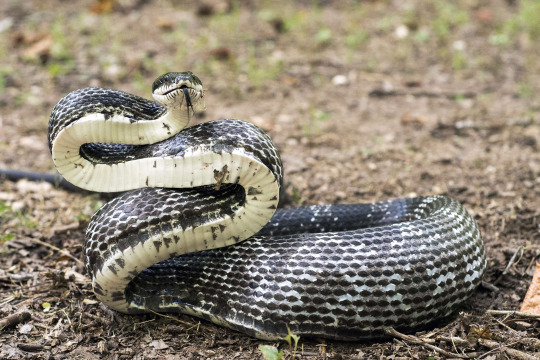

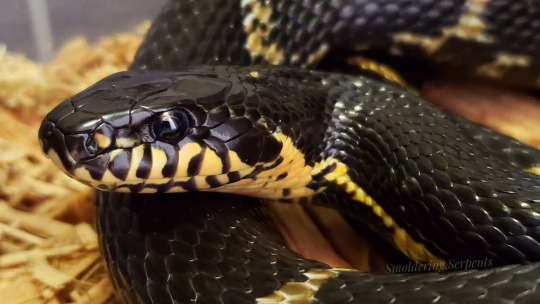
Kingsnakes are much easier to define - they belong to the genus Lampropeltis, and are exclusively North American snakes. They're cathemeral constrictors, like ratsnakes, but they can be distinguished by their diet, which consists largely of snakes and other reptiles.
They look superficially similar to ratsnakes, and also tend to be long and skinny in build, but kingsnakes tend to be shorter and have a longer, rounder shape to their heads and more well-defined markings. They have large, well-defined head scales. One of the best ways to tell is how shiny their scales are in comparison - kingsnakes always have smooth scales with an almost glossy look to them.

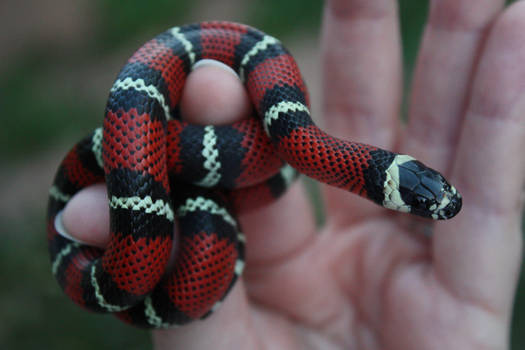
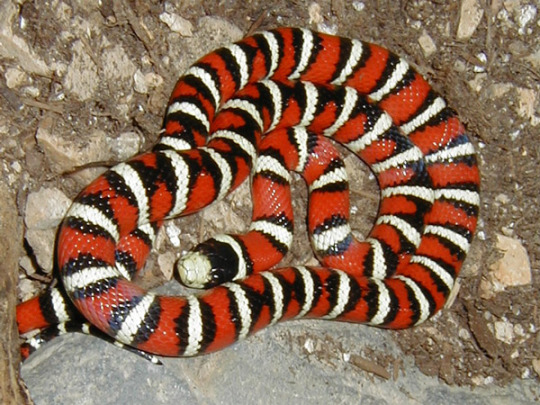
77 notes
·
View notes
Photo
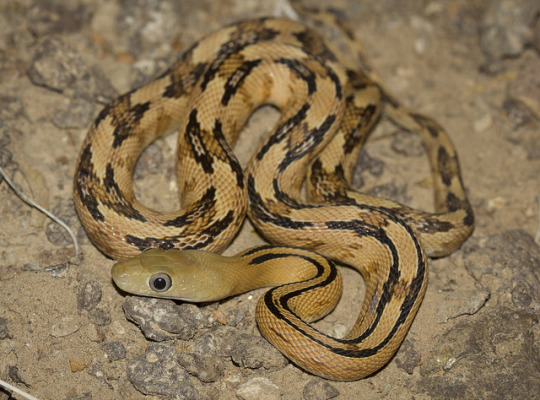
Trans-pecos Ratsnake - Bogertophis subocularis
Bogertophis subocularis (Colubridae) is a medium to large rat snake that occurs from south-central New Mexico, south-central Texas, down into the north-central and northeastern states of Mexico.
Trans-Pecos ratsnakes usually reach lengths of 76-140 cm, but occasionally reach sizes exceeding 165 cm. They are non-venomous, killing their prey (small mammals, bats, birds and lizards) by constriction. Only in rare instances will they defend themselves from humans by biting. Their large blue-grey or steel colored eyes suggest nocturnal hunting habits.
References: [1] - [2] - [3] - [4]
Photo credit: ©Ben L. Stupavsky | Locality: Trans-Pecos, Texas, US (2013)
#nature#animals#trans-pecos ratsnake#bogertophis subocularis#bogertophis#us#texas#mexico#fauna#wildlife#snake#reptiles#reptilia#squamata#serpentes#colubridae#zoology#herpetology#original
262 notes
·
View notes
Photo

The Trans-Pecos rat snake (Bogertophis subocularis) is a species of medium to large (1.0 - 1.7 m), nonvenomous rat snake in the family Colubridae. It is endemic to the Chihuahuan Desert though its range extends northward into Texas and New Mexico.
Nicknamed "subocs" by enthusiasts, they are unaggressive when approached, even passive, and are easily raised in captivity.
Photo [source]
158 notes
·
View notes
Text
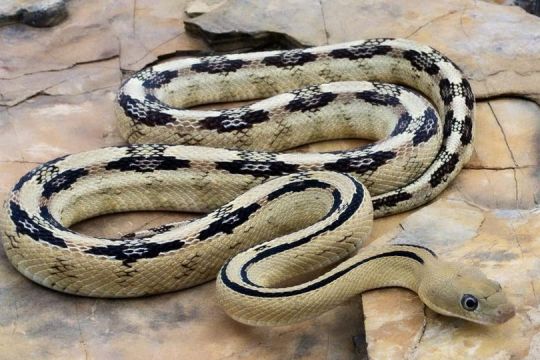
Trans-Pecos Rat Snake (Bogertophis subocularis), family Colubridae, West Texas, USA
photograph by Justin Coburn
22 notes
·
View notes